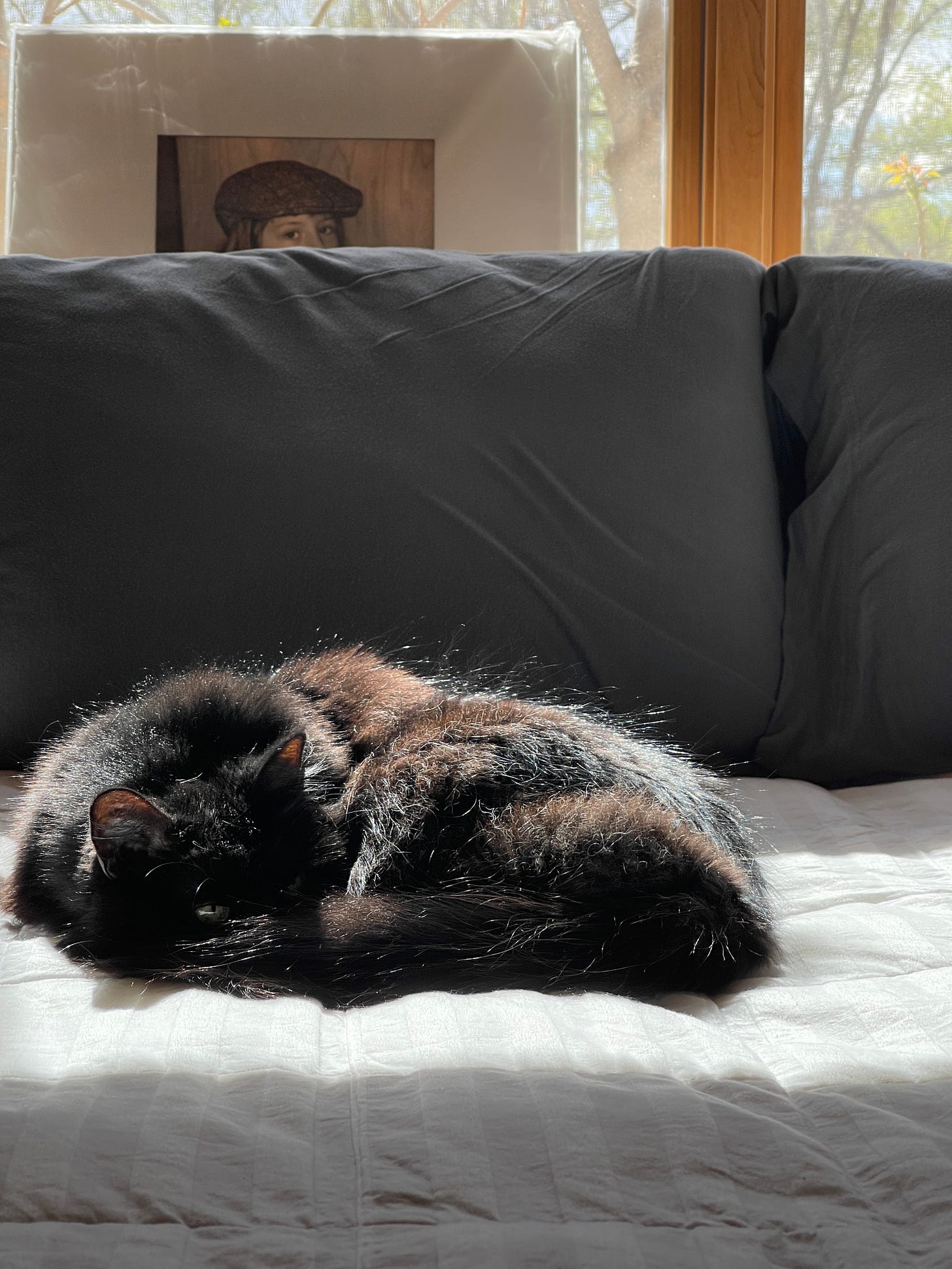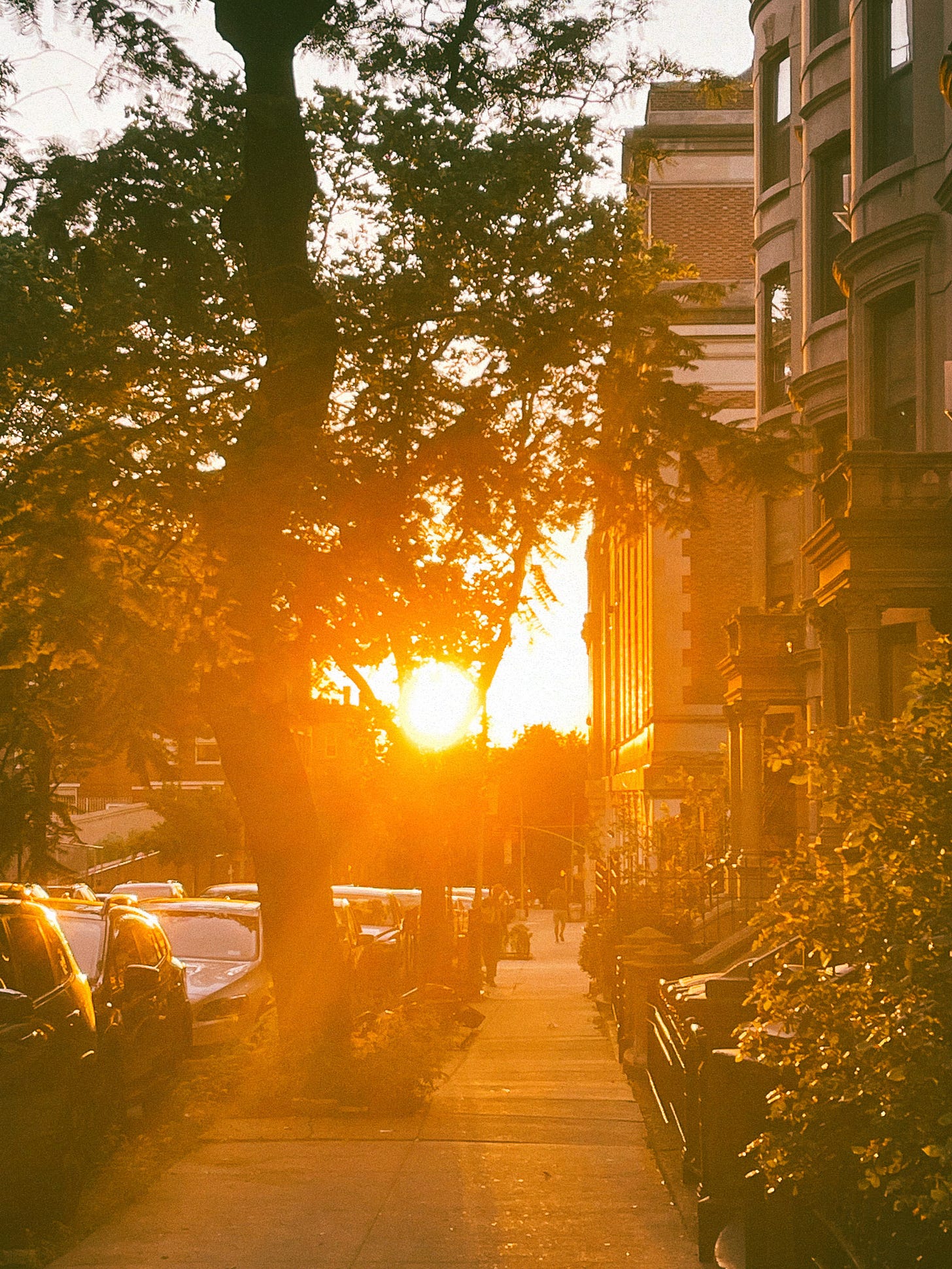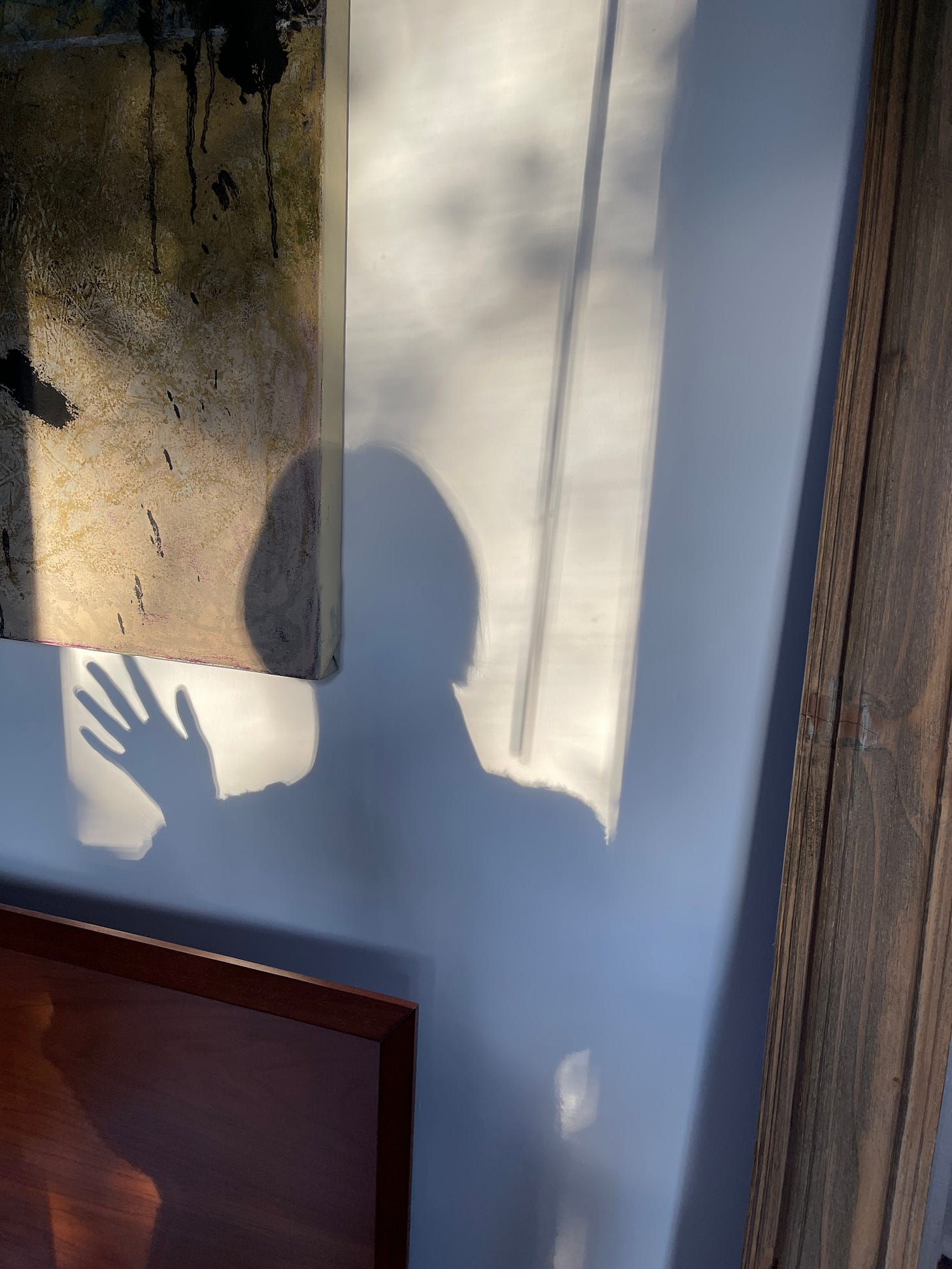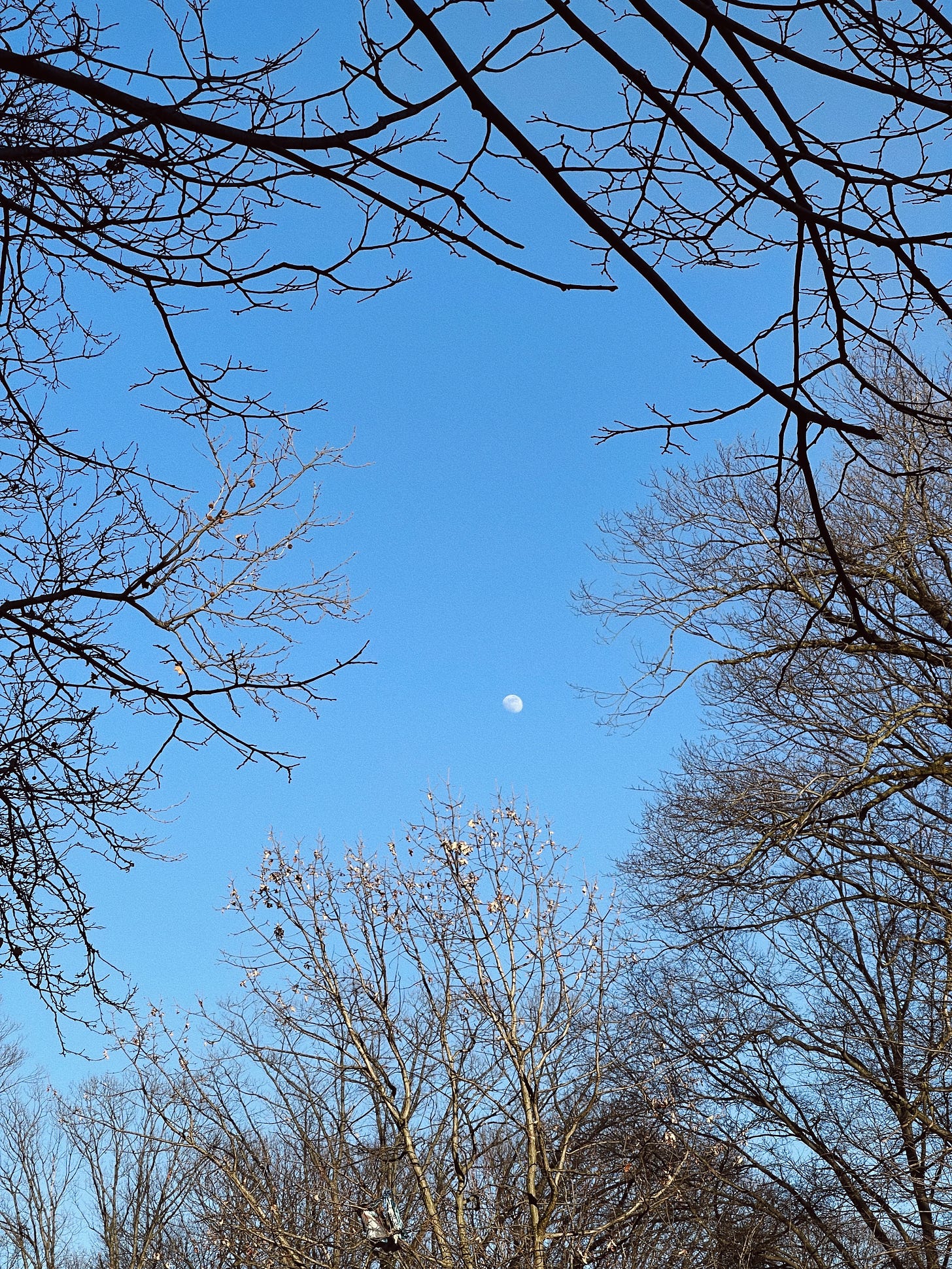PRESENT 1:41
I was having trouble remembering things. It began on the cusp of finishing my first book, a collection of essays, interviews, and prompts on time, creativity, and pace. Most stories I included took place from childhood to my late twenties, and as I wrote about these milestones, I felt I was approaching a wall off the page. I (of course) had life experiences beyond that period, but they had rarely coalesced into memories that would remain stuck between tissues and bones. Things that would hold on to me just as much as I would to them.
I’ve only recently really learned the difference between feeling the days and letting myself be touched by what they yield—inconveniences and miracles alike. But for one year, I didn’t let anything or anyone touch me. Instead, I shook and sweat and cried in despair. I was in the depths of a mental health spiral (and the somatic disruptions that accompanied it) reignited by an unexpected diagnosis a year prior, sustained by the stress of prolonged crises across the world. A lifelong dream was unfolding—I was writing a book—but in the process, I wanted to rid myself of so much of the period in which it was occurring.
From one spring to another, seconds felt slippery, minutes were lethal, and hours turned into wasted days. I struggled to find the right words for these sensations, mostly because everyone around me seemed to be experiencing the same degree of panic. What more did I have to offer to the narrative of anxious woman navigating Earth, anyway? So, I kept my thoughts to myself. I fumbled around rooms. It hurt to keep my eyes open, but I needed to learn how to really see again. Only so much could happen in the space between my frightened pupils and the bathroom mirror.
···
SPRING 2022
Long stretches of light had returned to the city, but everything in my life fell out of order. I was no stranger to what followed an anxiety attack, though, in the weeks leading up to winter’s departure, my anxiety was like a breath struggling to catch up with the rest of my body. The intensity of each episode was slowly building, signifying that I would soon cross over into new territory.
I went to visit my grandmother and father before they moved from the town that had rescued them both. The rental they were staying in was much darker than my grandmother’s previous residence, a verdant property filled with life. It was nice here too, just different. Distant.
When I wasn’t hiding in the unfamiliar bathroom—doubled over mid-attack, trying to keep my insides from spilling out—we gathered around my grandmother’s latest artworks underneath the lone skylight in the living room. I asked her if she was scared about her next chapter. She’d just left her home of twenty-plus years after all, and was moving again, states away, this time alone. She was leaving behind longtime friends. She couldn’t even bring her cat—whom she’d raised since kittenhood—instead forced to surrender her to a shelter. But my grandmother simply shook her head. She was doing “what needed to be done.”
What needs to be done is rarely easy. As I watched light and shadows move across her calm, stoic face during the drive to dinner, I felt that everything was about to change. Closer to home, I was about to sell my book, and there would be things I would also have to leave behind in order to do it. All the while, anxiety’s increasingly strong grip formed a fist. It began punching its way into my heart. I didn’t know how to write through the onslaught. I didn’t know what direction it would take me and who I would be by the end of it.
When I returned to New York, I picked up Etel Adnan’s Time on a whim and came across the following:
writing comes from a dialogue
with time: it’s made
of a mirror in which thought
is stripped and no longer knows itself.
···
PRESENT 4:10
When I look in the mirror, I feel the most trapped in a paradox: I display the same enthusiasm styling a new outfit as I do with a natural occurrence that has nothing to do with me: radiant sunsets splashing into the sky outside the adjacent window, leaf tornadoes rising on the ground a few floors below. I stand there, enchanted by these sights, before I meet my reflection again. In these moments, I’m brought back to a purer version of myself: there she is, underneath the materiality—nine years old at heart, dressed to the nines daily.
This tension comes in handy when I think back on my dark year: I begin by considering its opposite, like a game. In my journal, I write words and expressions containing light:
delight
plight
spotlight
nightlight
highlight
I’m wearing a red cashmere sweater when I land on light of my life. Being in the uniform color of love feels serendipitous, but I think about how light can feel more abiding than love. How it’s not partial to the individual. How it’s part of a collective of systems and phenomena beyond our reach.
···
SUMMER 2022
A run-in with COVID-19 in late spring cemented my fear of all illnesses by early summer. I stopped smiling, my skin drained of color. I stopped eating—nearly fifteen pounds lost in a matter of weeks. I stopped trying to explain myself as the world did its best to forget both the pain it had caused and endured. These “stops” continued to accumulate.
The season progressed, and my life grew smaller as the light around me grew lovelier: bright sun burned skin and sidewalks, and orange hues kissed the tops of brownstones and office buildings. On the rare occasions that I ventured out of my home, it was usually during golden hour. I wondered if other people were as moved by it as I was, though most shielded their eyes rather than gazing at the sky. But I kept looking up because it had become nearly impossible to look forward to anything else.
I wrote in fits and starts, conscious of my first deadline, battling the demons in my subconscious. August offered a momentary respite: I got engaged to my person on a plot of land upstate. When we returned home, I placed the ring on my finger and held it in front of me against a wall in my apartment, where, every morning, beams of prismatic light ambushed the moldings. (I say ambush because this light’s arrival was startling and stayed for no longer than a few minutes or so.)
Toward the end of the season, after another sleepless night, I stood against that same wall and let a streak of rainbow run down the center of my face. I took a selfie, smiling. It was a beautiful lie.
···
PRESENT 4:54
If I can’t bring myself outside in the company of others, the light in my apartment brings me outside of myself. It shifts with each season: smooth and alert in the warmer months, shimmering and mischievous in the back half of the year. It often dances across the pages that I read and write on. Sentences are broken and rebuilt in its presence: Shadows blacken an of or cast a spotlight on an in.
During that dark year, I could only see in shades of in: I was in a state of paralysis. I was not part of my community—family—in the ways they needed me to be. I was told that, in time, it would get better. Of course, it will get better.
In Stephanie Danler’s craft lecture “In Praise of Panic” for The Sewanee Review, she contends that panic is enmeshed with her art. “Back in the spring of 2022, my anxiety got to the point that I couldn’t even grocery shop,” she writes. “We were supposed to be out of a pandemic, and nothing in my life was where I left it.” It was here that gripped me—and also much later, when Danler ends the essay with two simple directives: Fight. Write.
This is my continued attempt. To fight. To write. To light the way forward—and sometimes back. To measure a year in light. To consider it beyond aesthetics. To not be afraid of its shapelessness.
···
FALL 2022
The days lost their shape, and I wrote in tandem with the seasonal shift. I reflected on how hard it was for me to make sense of time as a child. And how, instead of dates, I remembered details: a fluorescent classroom, a light leak at the playground, a flickering lamp in an old basement.
I read Deborah Levy’s living autobiographies. After I finished Real Estate, I thought about my own my own “unreal real estate.” I began sharing more—of what I called—light studies on Instagram: photo dumps of dayglow, sparkling bursts in my dining room. With this practice, I was building a home away from home: I tried to bottle light in images and add it to my “property portfolio.” I posted and projected something lighter than what I felt. The screen held and emitted light, but it reflected back to me things that I only wanted to see—until I sat down at the page and confronted the darkness that I could no longer justify living in my very real space.
···
PRESENT 5:03
Sometimes, when I read light, I see life. I don’t know if that’s just romantic thinking, but I do know that I try to live slowly, even though life moves fast, and some spaces can’t be filled.
NASA says that “we use light-time to measure the vast distances of space. It’s the distance that light travels in a specific period of time. Also: LIGHT IS FAST, nothing travels faster than light.”
LIGHT IS FAST. Perhaps the authors want to emphasize what so many of us can’t come to terms with.
The page tells me that a light-year is “the distance light travels in one year.” I can’t shake the phrase from my mind, so I keep searching: A light-year (or, in this case, lightyear) is the last name of the main character in a Disney film in which the fictional action figure Buzz Lightyear embarks on a cosmic adventure. A light-year is a special water bottle that comes in a subscription box. A light-year isn’t the same as a light year because life hasn’t felt light since 2016, and the load somehow continues to get heavier. A light-year is two words hanging on to either end of a small bridge: light-year. I love that light dashes into a year. Into darkness.
···
WINTER 2023
I stayed home and revisited Mieko Kawakami’s All the Lovers in the Night. The reserved protagonist, Fuyuko Irie, struggles to be with people—herself. “Why does the night have to be so beautiful?” she ponders in the novel's prologue. Irie’s (later-introduced) friend Mitsutsuka replies, “Because at night only half of the world remains.”
“Why is the night so beautiful? Why does it shine the way it does? Why is the night made up entirely of light?”
Night’s dark colors arrive halfway through the day in winter, and the remaining hours feel daunting. When the season came around again, I realized half the year had passed since I first read Kawakami’s words back in May. I realized I now felt half-human, writing my way towards a pulse.
When I wasn’t working on my own book, I was learning to meet myself in night's silence. In those long, drawn-out hours on the bathroom floor, unable to discern what was fiction or fact in my mind—grappling with my own whys—I was half awake, fully alone, trying to summon light from within.
“That night, everything was thrown into oddly sharp relief as if the pieces of the world before my eyes were telling me some kind of story,” Kawakami writes of Irie’s winter birthday walk. “It was an entirely familiar scene, except the usual rows of houses, telephone poles and everything else seemed to shine with a triumphant light.”
···
PRESENT 3:25
Today, the light is a flat gray—kinder than it has been in recent weeks. I’m told we’ll likely get heavy snow this winter, and I’m excited about the soon-to-arrive shadows cast by Prospect Park’s leafless branches. For now, I’m enjoying the very last remains of their autumnal beauty. As Mary Oliver writes in “When I Am Among the Trees:”
Around me the trees stir in their leaves
and call out, “Stay awhile.”
The light flows from their branches.
And they call again, “It’s simple,” they say,
“and you too have come
into the world to do this, to go easy, to be filled
with light, and to shine.”
I’m writing this as the light is leaving us for the day, sitting in my office with no overhead light on, just the computer screen, whose glow, from a distance, is reminiscent of the moon.
I’m wondering about time and space and how much they can confuse our bodies and minds. How in The Light Room, Kate Zambreno remarks at the end of her meditation on grayness that “space and time together form an infinite fabric, an outstretched blanket. That time is not straight but curved. That matter tells space-time how to curve, and curved space-time tells matter how to move.”
I continue to be moved by a science I won’t ever fully comprehend: Time has passed, light has traveled, color has exploded, and I have become sickened and healed. I recognize these cycles, yet I still never see them coming. Life is fast, but I’m trying to be in active conversation with the past—and look for light in the present—despite my anxieties and their long shadows.
I’m thinking about a time that was difficult to endure and now describe. But as Etel Adnan remarks in Shifting the Silence, “Thinking doesn’t always come from preceding thoughts: I suspect it’s always being born, even when it seems related to the past.” So, I’m slowly writing my way out of the shadows. I’m learning to write the memories that the past holds—protects—today. To let myself fall out of order, the way thoughts collapse into each other. The way light can transform dark years into old stories.
···
SPRING 2023
I turned in my book and turned my attention towards others’ work, one of which was Deborah Levy’s novel Swallowing Geography. In it, Levy writes of the protagonist J.K.: “When she meets a stranger and they tell each other their stories, she notes that it is always the people she leaves out of the stories that interest the stranger the most. … Therefore she learns that absence is often more interesting than presence.”
For one year, my presence was swallowed by anxiety and absence. But I knew that when I decided to tell you this story, I was going to have to consider what was there, even when I, myself, was fully not. And tell you how on the other side of it all—still trembling—I brought myself to that long overdue dentist appointment. Then, on a walk to take photos of the small buds waving at me on tree-lined streets. Then, further away from my comfort zone, on a crowded subway car grinding along the tracks.
And then, one day, I noticed the light in the courthouse contained a warm yellow hue. It calmed me as I rocked back and forth nervously in black satin flats and a white floral cloque dress. The dress had a cape—nothing like anything my literary heroines would wear—still, I felt the weight of it swaying behind me and told myself to wake up to this moment: You’re the light of someone’s life.
You’re the light.
I stood at the foot of the corridor, and his hand was in mine. We walked toward the room that marked our shared new beginning. Inside, the walls were painted a soft purple, like dusk. The officiant and photographer eyed us encouragingly, but they felt like specters. I absorbed the joy on my now-husband’s face. The sun was out, and so was I. He grinned at me, standing in front of a window.
For Your Next Chapter
If you enjoyed this slow story, here are a few others that might slow your scroll:
“In Praise of Panic” by for The Sewanee Review
I’d been trying to figure out how to write about this complicated year, and then I came across Stephanie Danler’s stunning craft lecture “In Praise of Panic” for The Sewanee Review’s Fall 2023 and saw myself in her words. (Isn’t that the most gratifying feeling?) Add this essay to your list and check out my interview with Danler on the Review’s blog.
Sad Happens: A Celebration of Tears by Brandon Stosuy and Rose Lazar
Ahead of my upcoming podcast interview with Brandon and Rose, I’ve been inhaling their glorious anthology of essays, art, and stories from Phoebe Bridgers, Matt Berninger, and many others. This lovely collection puts crying into various contexts and holds space for humanity. A must-read!
“The Sanctity of a Journal: On Private Writing in the Age of Public Content” by yours truly
Last year, I wrote about my relationship with diaries in an age of constant (digital) sharing. As you’ll read in the essay, I’ll be the first to admit that I’ve struggled with justifying adding yet another newsletter to the world… but as I write on the About page, I envision this as my literary third place—not quite book pages, not quite diary entries—instead, a place to slow down, reflect, and commune with you. So, thank you for reading. For being here.











Rachel, this was so beautiful.
wow wow wow. I have no words, your writing is so stunning, it has stunned me. Thank you for sharing such a beautiful and vulnerable piece, I absolutely can not wait to read every other thing you write <3